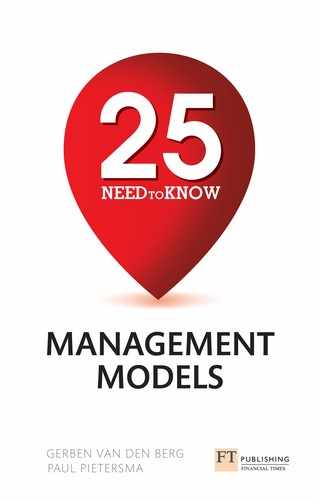Activity-based costing
- Why use it? Activity-based costing is used to allocate all costs to the activities the costs are incurred for.
- What does it do? Contrary to traditional cost accounting methods, activity-based costing (ABC) calculates the ‘true’ costs of products, customers or services by attributing direct and indirect costs based, not on volume, but on actual time and resources spent on required activities.
- When to use it? Activity-based costing can be useful if products/services or customer groups vary in complexity and handling costs.
- What questions will it help you answer? How can I determine customer value accurately, considering all costs I incur for this customer? What (indirect) costs are too high per activity? Are there any costly products that I should charge more for?
The big picture
Activity-based costing is a cost accounting model. It is used to allocate all costs, based on time spent on activities relating to products and services provided for customers. Traditional cost accounting models allocate indirect costs (overheads) based on volume. As a result, the costs of high-volume products tend to be over-rated, whereas the costs of low-volume products are under-rated. Contrary to traditional cost accounting methods, activity-based costing (ABC) calculates the ‘true’ costs of products, customers or services by attributing indirect costs based, not on volume, but on required or performed activities.
Instead of using broad arbitrary percentages to allocate costs, ABC seeks to identify cause-and-effect relationships to assign costs objectively. Once the costs of the activities have been identified, the cost of each activity is attributed to each product, to the extent that the product uses the activity. In this way, ABC often identifies areas of high overhead costs per unit and is able to direct attention towards finding ways to reduce the costs or to charging more for costly products.
There is an underlying assumption when using the ABC model that costs are generated not by the products or customers themselves, but by the activities required to make or serve them. As different products require different activities, each of which uses a different level of resources, the allocation of costs should be weighted accordingly.
When making business decisions, knowledge of true costs can help to (Figure 8.1):
- establish economic break-even points;
- identify ‘profit makers’ and ‘losers’ (i.e. assess ‘customer value’);
- highlight opportunities for improvement;
- compare investment alternatives.
Figure 8.1 Activity-based costing
Source: adapted from Cost and Effect: Using Integrated Cost Systems to Drive Profitability and Performance, Harvard Business School Press (Kaplan, R.S. and Cooper, R. 1998), Copyright © 1998 by the Harvard Business School Publishing Corporation, all rights reserved. Reproduced by permission of Harvard Business School Press.
When to use it
Activity-based costing can be useful if the overhead is high and the products/customers are highly varied regarding complexity and handling costs. Activity-based costing turns indirect costs into direct costs. A more accurate cost management system than traditional cost accounting, ABC identifies opportunities for improving the effectiveness and efficiency of business processes by determining the ‘true’ cost of a product or service.
Other models that are similar to ABC are total cost of ownership (TCO) and life cycle costs. TCO is a calculation that reflects the total cost of the investment, including one-time purchases, recurring costs and operating costs. The TCO concept is widely used in information technology (IT) implementations where the benefits are hard to quantify and the focus is on minimising the project costs. A life cycle cost analysis calculates the cost of a system or product during its entire life span.
How to use it
There are five steps involved in performing a simple ABC analysis:
- Define the cost objects, indirect activities and resources used for the indirect activities.
- Determine the costs per indirect activity.
- Identify the cost drivers for each resource.
- Calculate the total indirect product costs for the cost object type.
- Divide the total costs by quantity for indirect cost per individual cost object.
Cost objects are products, customers, services or anything else that is the object of the cost-accounting endeavour. Activities could be anything a company does to operate its business: receiving, loading, packing, handling, calling, explaining, selling, buying, promoting, calculating/computing, writing orders, reading orders, etc. Indirect activities are not directly attributable to cost objects. Resources are machines, computers, people or any other capacity or asset that can be (partly) allocated to an activity.
The final analysis
Activity-based costing enables segmentation based on true profitability and helps to determine customer value more accurately. As such, it is the first step towards activity-based management (ABM). ABC does not assess efficiency or the productivity of activities, even though this may be extremely important for improvement. In addition, ABC assumes that it is possible to identify unique cost objects, activities and resources. At the end of the day, the outcome of an ABC analysis is only as accurate as its input.

